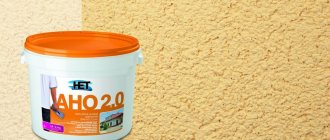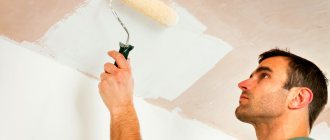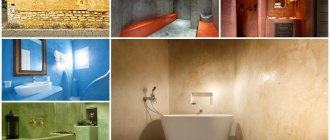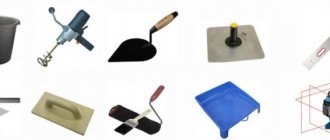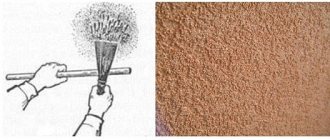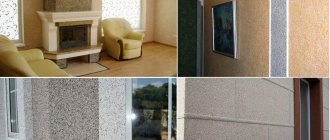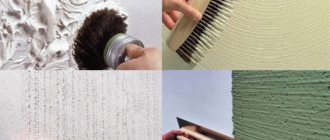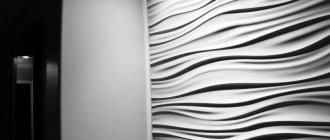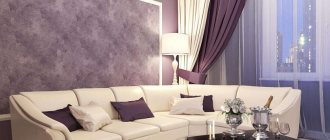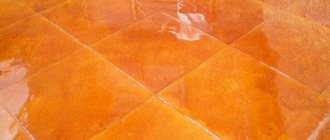Types of mineral plaster, depending on the filler
The filler of mineral plaster plays not only a decorative role. The manifestation of certain characteristics depends on the type of filler. According to sanitary standards, it is prohibited to decorate interiors with plaster containing mica, glass or anthracite. For external work, the filler fraction can be any. At the same time, for finishing the house, a mixture with medium and coarse filler is used.
Different types of filler add various properties to mineral plaster:
- The glass filler has the form of balls. Colored glass as an additive will give a more beautiful appearance.
- Plaster with decorative colored clays is used exclusively for interior work due to its low strength. The surface can be either smooth or textured in appearance.
- A by-product of expanded clay production is ceramic granules. They provide texture as a filler, but to give the desired color, it is recommended to paint the composition.
- If dark plaster is required to create the desired effect in the design, it is better to use anthracite plaster. Anthracite filler is a by-product of the mining industry, such plaster does not cost much.
- Quartz is sand of a larger fraction. This type of mineral plaster is inexpensive, safe and has a good decorative effect.
- Marble chips as a filler give the surface a more expensive appearance and additional strength.
- Terrasite plasters contain mica, which can reflect light. On a sunny day, a facade plastered with this composition has a spectacular appearance.
Knowing the properties of certain additives, you can easily select the most suitable one in terms of properties and decorative qualities. Among the variety of mineral plasters, there will certainly be one that will highlight the chosen design.
Application area
Mineral decorative plaster is a composition based on granite and marble granules, hydrated lime, anthracite, crushed quartz, mica, glass, colored clay, ceramic balls, white Portland cement and light aggregates. The dry mixture is sold in bags. It must be diluted with water before use, checking the instructions on the package.
Apply the mixture with a trowel or an ordinary spatula; there is nothing complicated in the application process: even a novice master can handle it. But when processing a large area, it is advisable to use a mechanized application method. If a layer thicker than two centimeters is applied, then a reinforced mesh is required. After drying, the solution forms a porous, durable, non-flammable layer with excellent sound and thermal insulation. This finish will require a mandatory finishing coat from the craftsman, since it is adversely affected by climatic influences.
The finished mixture contains additives that increase the moisture resistance of the coating. Vapor permeability is maintained. Thanks to this, this coating prevents the formation of fungi. This plaster performs two functions at once: practical and decorative. At the same time, it serves as an additional thermal insulation layer.
Plaster does not tolerate stress and vibration well, so it should not be used until the structure has completely settled, when finishing houses that are located close to the railway or in a turbulent seismic zone.
Mineral plaster allows you to create different textures on the wall , the most popular include:
- bark beetle;
- travertino;
- grooves;
- fur coat;
- lamb.
Coarse mixtures are usually used for facade work and decorating certain elements in the home interior. Mineral fine-grained plaster is more convenient to work with compared to coarse-grained plaster. The texture can be applied with a brush, roller, or even improvised materials if a roller is not at hand.
Fine-grained mineral plaster is in great demand . It contains marble chips. It is with its help that a luxurious Venetian coating under polished stone is created. The decorative effect is created through a special application technique: small strokes and a very thin layer. In this case, each layer must be sanded and ironed. The Venetian coating in the interior goes well with stone, wood, and modern materials.
For interior work, it is not recommended to take mixtures that contain glass, mica, or anthracite, since dust from these substances can be harmful to human health. For interior decoration, it is better to choose materials with quartz or marble chips.
On average, four kilograms of mixture are used per square meter, but in practice the figure differs significantly. Consumption will directly depend on the granularity of the solution and the quality of the working surface. The larger the fractions, the thicker the layer will be, therefore, more solution will need to be used.
Composition and characteristics of mineral plasters
In addition to mineral fillers, the composition includes substances such as slaked lime, white cement, and substances to impart plasticity to the mixture. The plaster lays smoothly and firmly on any material, while being used sparingly.
Mineral plaster is very durable. It does not crumble or crumble. The cost, which is slightly higher than some other types of mixtures, is easily compensated by the fact that re-plastering will not require a long time. The surface is “breathable”, freely allows air to pass through, and at the same time has water-repellent properties. Easy application and the smooth surface obtained without much difficulty is an advantage over many other types of finishing materials.
Also, this plaster has the following positive qualities:
- Complete absence of flammability;
- Weather resistant;
- Environmentally friendly;
- Easily adheres to all materials;
- Easy to clean;
- Excellent thermal insulation and sound insulation qualities;
- Resistant to fungi or mold.
In addition to the positive ones, there are, like any finishing material, some negative aspects .
- This plaster should be stored in a completely dry place.
- When preparing the mixture, you must strictly follow the instructions so that the result does not disappoint.
- An experienced craftsman should apply the plaster due to the rapid drying of the solution.
- In addition, mineral plaster is not resistant to vibration.
The average technical characteristics of mineral plaster will be as follows:
- When applying the mixture to 1 square meter with a thickness of 1 millimeter, approximately 1.5 kg of dry plaster will be consumed.
- In order to dilute 25 kg of mineral plaster, up to 5 liters of water may be required.
- The viability of the façade mortar is 1.5 – 2 hours.
- The layer thickness should be from 2 to 30mm.
- The optimal air temperature when applying plaster is from 10 to 25 degrees.
Thus, mineral plaster has a number of advantages and a minimum number of undesirable properties. Thanks to this, this type of finishing materials has become widespread and very popular.
Instructions for applying mineral plaster mixtures
Each type of decorative plaster texture has its own application technology. However, there is a sequence of actions that is typical for everyone.
Each time the amount of working mixture must be mixed to process one gripper in order to have time to completely work it out before setting begins.
The thickness of the layer depends on the size of the filler granules and should be slightly larger than the largest ones. The final finishing should be done with a polymer or foam float, since the metal leaves irreparable marks.
In case of a forced stop of the process, a strip of masking tape must be glued to the edge of the already applied plaster to slow down drying.
Before plastering begins, the wall must be prepared for work. To do this, the surface is cleaned of all types of contaminants, cracks and severe unevenness are covered. Next, the wall is primed twice and dried.
Interior decoration
When performing work, the plaster solution is distributed over the wall in the minimum possible layer. It is recommended to apply the mixture from the bottom up, but not to do it over a large area at once in order to maintain the possibility of creating the necessary texture.
The sketched rough layer is leveled with a metal spatula, which should go along the surface at an angle of about 15 degrees.
The textured layer is applied over the already leveled rough layer. If the solution is applied mechanically, then all leveling should be done only by hand.
Application of mineral plaster
This type of plaster is not recommended for initial work. Nevertheless, the characteristics and excellent appearance of the finished surface make it possible to use this material for external and internal finishing works of buildings for various purposes. In addition to finishing residential buildings, such plaster is used to decorate passages, station buildings, and industrial premises. Cultural premises, public buildings and restaurants also cannot do without this material. Durability and variety of textures allow you to choose the mineral plaster that is most suitable for the purpose of the room and design. The scarcity of colors is easily compensated by tinting, so you can choose any desired shade. Since the surface is easy to clean, mineral plaster is easy to maintain and does not create additional problems during operation.
Decorative plaster
Mixtures of this type are used for interior decoration. They perform two functions at once:
1. Protect the surface of the walls.
2. Give them a certain texture.
Wall decoration with decorative mineral plaster
When choosing a suitable option, you should pay attention to the following indicators:
- type of binding base;
- type of filler;
- granule size.
Preparing walls before plastering
It is important to remember that the building must be completely settled and other types of work completed before applying mineral plaster. Failure to comply with this requirement may result in cracking of the finished façade.
To prepare the walls, you need to clean them from dust and dirt with a wire brush. If soot is present, it must be removed with a 3% solution of hydrochloric acid, and then rinsed with water. Oil stains should be covered with greasy clay. After complete drying, the clay must be cleaned off and the wall washed with water. Cracks and irregularities must be covered with cement mortar. Notches are applied to the prepared wall for better adhesion of the plaster to the base. After this, a primer is applied, and it is worth choosing a primer composition with an antiseptic effect to better resist fungi and mold.
If plastering will be carried out over insulation, it is necessary to install a plaster mesh. Having diluted the composition according to the instructions and wetted the tools, you can begin to work. It must be remembered that the plaster mixture must be prepared immediately before application. The finished plaster should sit for 10 minutes, after which the thickness should be of a creamy consistency.
Advantages and disadvantages of plaster
Mineral plaster mixtures are valued by professionals and users because their advantages are obvious:
- high degree of adhesion with all building materials (concrete, brick, plasterboard, gas blocks, etc.);
- resistance to ultraviolet radiation, temperature changes, frost, heat, precipitation;
- low thermal conductivity, excellent thermal insulation properties;
- high mechanical strength, wear resistance, long-term preservation of coating integrity;
- vapor permeability - the ability to get rid of accumulated moisture, no fogging of walls, reducing the risk of fungus and mold growth;
- fire safety, non-flammability, possibility of use as a fire retardant layer;
- ease of care - plaster can be washed with water, detergents, vacuumed, wiped, cleaned with brushes;
- increased level of acidity, which prevents the proliferation of microbes and fungi;
- environmental friendliness, absence of unpleasant odor and released toxins;
- affordability (except for marble plasters);
- a wide variety of options, the presence of many types of plaster with a decorative effect.
Mineral mixtures also have disadvantages. If you violate the ratio of the proportions of cement and other mineral additives, and also incorrectly dilute the plaster with water, the solution may lose its strength and some of its other useful properties. Such cladding can crack and crumble over time. Finishing work with decorative plaster is carried out only by hand, therefore it is considered quite labor-intensive and time-consuming, especially if the surface has a large area.
When buildings shrink and vibrate, the plaster layer can crack, because the elasticity of mineral mixtures is at a low level. Compared to silicone, silicate, and acrylic plasters, the service life of mineral compositions is short, so repeated repairs will have to be done faster. In addition, mineral mixtures are rarely colored, and you will have to tint them yourself.
If the components in the composition are gray, the final shade may not be attractive. And the last disadvantage: before plastering a house or apartment, it is better to practice on a rough surface. The finished solution has a limited service life, hardens quite quickly, and it will be difficult for a beginner to handle it.
Technique for applying mineral plaster
1. Interior decoration of the room.
For interior work, it is necessary to spread the plaster in a thin layer not exceeding the size of the fraction. It can be applied from top to bottom or vice versa. It is not recommended to apply the mixture over the entire wall area at once if you want to create a texture. The rough layer is leveled with a spatula, and the angle between the tool and the wall should be approximately 15 degrees. The texture is applied over a fresh layer. The corner is formed using a perforated corner. It needs to be pressed to the corner, plaster applied on top, and then leveled. It is possible to apply the composition by machine, but leveling must be done only by hand. If the finished finish needs to be painted, this should only be done after the plaster has completely dried.
2. Facade finishing.
Plastering a facade differs in the technique of applying the mixture. After the preparatory work, the first layer of plaster is applied. This layer is applied by spraying, no more than 5 millimeters thick, after which it is rubbed over. A day later, the main primer layer is applied. Its thickness should not exceed 8 millimeters. The layer is also leveled and left for a day. The covering - the finishing layer of plaster - depends on the fraction of mineral additives and varies from 2 to 5 millimeters in thickness. As in the case of interior work, the texture is applied over a fresh final layer. After complete drying, painting can be done if necessary.
Nuances of application inside and outside
Each type of mineral plaster has its own application techniques. Therefore, details of how “bark beetle”, “fur coat”, “wet silk”, etc. are applied to the wall can be found in the relevant articles. Here we will consider the nuances characteristic of the bulk of mixtures. Let us immediately note that there are no significant differences between working indoors and outdoors. Application techniques are the same. But there are small tricks unique to this type of plaster.
- All tools are moistened with water before contacting the solution - this prevents the plaster from sticking to the trowel or grater.
- The solution is mixed for one “capture” - the area of the wall onto which the solution can be applied before it sets in the container.
- Restoring the consistency of the solution with water is strictly prohibited. A screwdriver or electric drill with a mixing attachment can help here. If this method fails to restore the fluidity and plasticity of the composition, then the diluted plaster is thrown away.
- The thickness of the plaster layer depends on the size of the filler granules - they must match.
- The final surface treatment is done with a plastic float - the metal leaves marks that cannot be removed.
- During forced breaks, masking tape is applied to the borders of the applied plaster - it slows down the hydration process.
Is it possible to apply mineral plaster to the floor?
Yes, you can, but not the usual plaster for walls. Manufacturers have been producing special flooring mixtures for several years now. There, the types of additives that increase the wear resistance and abrasion of the floor covering have been changed.
Facade repair
For restoration work, it is necessary to take plaster that matches the strength and characteristics of the old mixture. The use of more durable types is not acceptable. With a high degree of probability, in this case, the fresh plaster will peel off from the old layer. In this case, to repair cracks and cracks, it is necessary to use a cement type of plaster. If it is necessary to refresh the appearance of the building, use a terrazite mixture. The plaster is applied in a thin layer depending on the filler fraction, leveled and, if necessary, a texture is applied.
average cost
Pebble plaster will cost more than that created on the basis of cement. The cost of one package of 25 kilograms will vary depending on the specific brand. Other factors also affect the cost of finishing materials:
- place of sale;
- category, grade;
- type of mixture;
- mixture composition;
- region of production.
For example, a bag of Ceresit mixture sells for an average price of 550-850 rubles, Teplon - 450-500 rubles, and Krysel costs an average of 400 rubles. But the price range can be quite serious. At Vetonit, the price varies from 600 to 2500 rubles.
If you follow all the rules for applying mineral plaster to the surface, safety precautions and purchase high-quality finishing materials, the resulting finish will last a long time without losing its aesthetics and without cracking.
Applying the “Bark Beetle” texture
“Bark beetle” is currently one of the most popular types of texture. The appearance of the finished wall looks like wood worn away by a bark beetle. Applying such a texture is not difficult; it is easy to do even for the least experienced craftsman.
After the initial preparation and plastering of the walls, you need to take a construction trowel and rub the wall. The granules, clinging to the tool, will make the necessary grooves. You can move the grater depending on the desired result - vertically, horizontally, in a circular motion. The resulting grooves will be located in the appropriate direction.
Plaster application technology, which is necessary for work.
The sequence of actions performed when applying it is no different from any other. For work, as well as when applying other types, protective equipment is used. It is necessary to protect exposed skin, because... the composition has an alkaline pH. The tools you will need are:
- Mixing containers (if dry mixture is used);
- Construction mixer (optional);
- Spatulas of different sizes;
- Steel grater (for applying the composition);
- Trowel;
- Plastic grater (to create texture, optional).
In addition, you may need:
- Masking tape;
- Lighthouses;
- Plaster mesh with screws;
- Corner profiles.
Initially, the walls are leveled using starting compounds if they have obvious defects such as depressions, crooked bends, holes and cracks. You need to get rid of them in advance.
After such preparation, excess cement mortar may remain, which will also need to be disposed of. This is done using sanding tools, for example, medium sandpaper. Additionally, if there are stains, the wall must be degreased. If plastering is carried out on mineral wool insulation or other soft base, laying a painting (plaster) mesh is required. It is attached to the prepared base, and a starting plaster mixture is applied on top.
Before applying the finishing composition, the wall is primed to improve adhesion. The tools are moistened with water so that the composition does not stick and they begin to work. It is necessary to calculate in advance how much composition will be needed to cover a specific area, because... it will be covered in one go. Excess solution will dry out and will be unsuitable for further work.
If the finished plaster purchased in the store does not have a convenient consistency, it can be diluted with tap water and mixed until smooth. This is a necessary condition, because a heterogeneous mass will create streaks that worsen the appearance. The consistency of thick sour cream is considered optimal.
When creating a geometric pattern or combination of colors, masking tape is applied to the surface along the drawn or marked lines. Application of the solution is allowed from top to bottom and from bottom to top. The angle between the wall and the tool is 15 degrees. The layer should be thin, not exceeding the thickness of the largest fraction of the composition. First, apply a rough layer and then level it with a spatula. Then profiles are laid on the corners, pressed and also covered with building mixture, after which they are leveled.
When processing with a composition of the “Bark Beetle” type, the next stage is the creation of texture. It is done using a plastic grater using circular or linear movements, depending on the desired result. Then a technological pause of 15-20 minutes is maintained for initial setting and the masking tape with still damp residues of the composition on it is removed. After final hardening (1-2 days depending on the brand), the surface can be varnished.
The composition can also be applied using electrical equipment, but leveling the surface is done manually. When working outdoors, the treated surface must be protected from debris and wind while it dries.
Application in design
For interior decoration, mineral plaster is more common in offices and other similar buildings. However, pebble mineral plaster is more than suitable for decorating a bathroom. It is not afraid of moisture, is resistant to mold, and is easy to clean. When decorating corridors, hallways, and stairs with “Bark Beetle” plaster, a spectacular style will be created. It is important not to overdo it when emphasizing the finish with details. In this case, the interior will be overloaded and will be more difficult to perceive.
When decorating a room, you can take into account that there is no need to completely plaster the walls. You can highlight the fireplace area, door and window openings.
Usage
The scope of application of facade mineral plasters is not limited only to the walls of a residential building. Since plasters have excellent strength characteristics, they are used in other places, for example, in industrial buildings, cafes, restaurants, cultural institutions, train stations, underground passages and so on. They withstand almost critical operating conditions perfectly. Mineral plaster is often used to decorate building plinths and staircases.
Application of mineral decorative plaster
On a note! It is not advisable to use mineral plasters for rough work. Usually they are applied to an already prepared and leveled wall surface. But this material perfectly replaces tiles, wallpaper, and any other coverings both outside and inside the house.
Mineral plaster can also be used for finishing buildings located in large cities, since it is easy to clean. It is used in various climatic conditions, as it can withstand changes in humidity and temperature.
Another example of using such plaster
Popular manufacturers
Mineral plaster is produced by most companies involved in building mixtures. The most popular of them can be called
- "Caparol"
- "Volma"
- "Bayramiks"
- "Ceresit"
- "Baumit"
- "Bolars".
These companies produce both dry and ready-made mixtures, of various types, colors and textures. The cost depends on the manufacturer and composition of the mineral plaster. The most expensive is Venetian plaster with a wax coating.
Mineral plaster is the best way to decorate a facade or refresh the interior. Thanks to its characteristics, it is suitable for finishing any room. A variety of types will allow you to choose the ideal finish that matches the chosen design.
“Bark beetle” plaster: photo, selection, application
Venetian plaster: application, photos of completed work
Types of facade plaster
Plaster as a finishing material for walls and ceilings has been used for thousands of years and is still considered, perhaps, the most universal way to decorate various surfaces. It was released during the heyday of the Roman Empire, when plastered walls were very popular among the wealthy. However, Romans of average and low income could also afford to decorate their homes with plaster.
It is interesting that even decorative finishing plaster appeared precisely in Ancient Rome, since during the production of large stone blocks a large amount of small stone debris was obtained, and the inventive Romans decided to turn it into decorative plaster. It began to be used to decorate walls and ceilings in temples.
Wall decor with plaster - from Ancient Rome to the present day
Nowadays there is a huge selection of plaster on the construction products market; all sorts of varieties and color variations of this material have appeared. The easiest way to classify them is by the substances that are used in their manufacture.
From this point of view, plaster can be:
- silicate;
- acrylic;
- silicone;
- mineral.
Each of these types has its own characteristics and features, which are associated not only with the appearance of the material, but also with the technology of application to the work surface.
Types of facade plaster structures
Silicate plaster based on components of mineral origin. And the binder is potassium liquid glass. This material is characterized by low elasticity, has high vapor permeability, is not afraid of dirt, and therefore remains clean for a long time, which is why the walls do not require special care.
Silicate plaster is often used on difficult-to-work surfaces, for example, cellular concrete, shell rock. It can have a lot of shades and is sold ready-to-use. The main disadvantage of silicate plaster is the likelihood of small cracks appearing on its surface.
Silicate facade plaster
Acrylic plaster is a plastic material that is resistant to sudden temperature changes, which is often used specifically for finishing the facade of buildings. It is easy to give it the desired color using color schemes. It has excellent vapor permeability, is elastic, and parasites and pathogens do not live on it. Also, there are especially many acrylic plasters on the market.
Acrylic facade plaster
The main disadvantage of using acrylic plaster is its “magnetism” towards dirt. All dust will certainly settle on surfaces covered with this finishing material. Fortunately, it is easy to return plaster to its former appearance - just rinse the wall with water, since dirt does not eat into the surface. Also, acrylic plaster is quite difficult to apply due to its high drying speed, so it is necessary to cover the entire wall at once, if possible, taking breaks only when moving to another plane.
Acrylic plaster “Lamb” GRANIKOT ACRYLIC
Silicone plaster is considered the most expensive. Thanks to the silicone base, you can add any filler to it, for example, quartz sand, which makes the surface look like it has been plastered with a material like real stone. Silicone plaster does not attract dirt, is elastic, and has excellent vapor permeability.
Silicone decorative plaster
Prices for various types of decorative plaster
Decorative plaster
What is textured plaster?
Modern textured plaster is a heterogeneous plastic mixture for decorative finishing of walls, ceilings and other building structures (columns, various architectural elements). In addition to the binder, it contains insoluble fractions that make it possible to create a certain texture on the coating by grouting after application.
Figure 1. Surfaces plastered with a textured mixture
Distinctive features of textured decorative plaster:
- High strength characteristics – ensure durability of the coating and resistance to mechanical damage.
- Possibility of eliminating minor wall surface defects.
- Simple application - unlike structural mixtures, the decorative qualities of which depend directly on the skill and imagination of the artist, to obtain the original texture you just need to grout the applied coating.
- Increased ductility and long-term viability.
- Practicality - during operation it does not require special care; it is enough to periodically wash the surface with soapy water.
Application for outdoor work.
Due to the fact that mineral plaster has good resistance to weathering and moisture, it is used for facade work. It has proven its durability in practice.
Mineral plaster for facades withstands frost, heat and daily temperature changes
In addition, it is resistant to most detergents, which is important in cities with heavy traffic. Mineral plaster for facades is often used for finishing plinths, external stairs and entrances
In addition, it is used both for finishing individual elements and the entire facade. Mineral facade plaster does not burn, and therefore it is used as fire protection for surfaces prone to fire, for example, wood, MDF or chipboard.
Types and features of application
Depending on the scope of application, mineral plaster is divided into facade and decorative. There are a number of significant significant differences between them regarding both appearance and technical characteristics.
Thus, the mixture for interior work is more decorative, but cannot be used on external walls, since it is not resistant to external factors.
Facade ones are resistant to various negative influences and look rough on interior walls.
By structural type they are distinguished:
- bark beetle, which contains significantly fewer granules, and the pattern appears on the surface after hand movements that are made only in one direction: horizontally or vertically; the resulting pattern resembles a cut of a tree damaged by a bark beetle;
- the fur coat is made with a composition containing fine-grained filler and using a special application technique; first, plaster is applied to the surface of the walls, smoothed and a special roller is rolled over the wet surface or simply a trowel is applied and with a sharp movement it is torn off the wall; this is how the “fur coat” appears;
- Venetian is performed using a special application technique; strokes with a spatula are made in a chaotic manner, the composition is applied in several layers, each layer is sanded and ironed, be sure to be coated with wax, and then polished, achieving not just an even and smooth, but also a glossy surface;
- pebble or lamb; the surface treated with it resembles the skin of a young lamb; to achieve this effect, the composition applied to the walls is distributed in a circular motion, and a certain pattern appears due to the inclusion of small granules of ceramics or minerals in the mixture. For more information about the use of mineral mixtures, watch this video:
Another important advantage of mineral plaster is its affordable price. Having decided to carry out finishing work on the facade of his country house or decorate the walls of a balcony, the consumer will always be able to purchase a dry plaster mixture without extra material costs and carry out the work independently
Mineral plaster is a natural, environmentally friendly material, which is a dry construction mixture that is used for both interior and exterior work.
Applying plaster under concrete with your own hands
Beginners will find it easier to work with a flat surface that does not require additional plastering. However, before using decorative plaster, the surface of the walls should be prepared.
Preparatory stage
If the room had old decoration, it must be completely removed. Features of this stripping:
- Plaster that does not adhere well is removed. A thick layer of plaster layer is removed with a spatula, hammer and chisel, ax or hammer drill.
- The wallpaper is moistened with water and torn off by hand. You can pry them off with a spatula.
- If there is paint on the walls, it is more difficult to remove. It is scraped off with a brush or grinder with an attachment.
Another option is a hair dryer. It heats up the paint and is easy to remove with a spatula and scraper.
Then the walls are being repaired. You need to clean them, remove all cracks, defects and irregularities.
The cracks are widened with a chisel, cleaned, primed and filled with a repair mixture.
The next stage is priming the walls. The entire surface of the walls is covered with an even layer, which will improve adhesion. Apply primer with a roller or paint brush. You can continue work only after the primer has dried.
Preparing the solution
It is easier to work with ready-made concrete compositions. But, their cost is high, so most often they resort to dry mixtures. The packaging indicates how to prepare the composition. The proportions of water and the sequence of work are indicated there. It is different for each concrete composition. The main thing you need to know is that first water is poured into the container, and then the plaster is poured for mixing.
The contents are mixed to a paste-like consistency. This is not done manually, but using a construction mixer. Then the mass is kept for up to 10 minutes; it must not be touched. This will help the concrete plaster to mature. Afterwards, the contents are mixed again and now everything is ready to make an imitation of concrete with decorative plaster.
Applying the first layer
The first fine-grained layer will be 0.5–2 mm thick. It is applied using a spatula or trowel. Using a grater, spread the mixture over the wall. This is a kind of pillow under the main layer. After setting (about 40 minutes), the surface is treated with a construction trowel. The wall is rubbed with movements in a circle counterclockwise. The process is performed at temperatures above +5 ℃. At a temperature of about 20 ℃, the applied layer will dry in 2 hours.
Main decorative layer
It will be visible to everyone and will imitate a concrete wall. Various effects and patterns are obtained using certain tools that we discussed above.
The surface can be smooth or textured. It all depends on the desire. The process starts from the ceiling, from the corner of the room. As work progresses, they move down and to the side.
Application methods are as follows:
- A layer of plaster (no more than 5 mm) is applied to the area, and a certain impression is created with a roller or polyurethane stamp.
- The next option is to create a chaotic or regular pattern on the wall. To do this you need a brush, broom, spatula, cellophane or other available means.
- The texture is obtained using a spatula, smoother or trowel. It is enough to apply the plaster under the concrete with strokes or circular movements. This is how the drawing is created.
- And to make the surface rough, after the solution has set, the wall is treated with a plastic or polyurethane trowel. The pressure is not strong.
After a day, the concrete plaster will dry and gain strength. Then the protrusions and sharp ends are smoothed with a medium-grit float. This way you can use decorative plaster to create a beautiful finish in a room.
But that is not all. Finally, the surface is treated with a water-based impregnation. It can be transparent or tinted. If desired, the plaster can be painted to imitate concrete. This creates a room in minimalist or loft styles.
